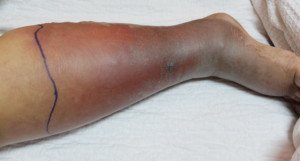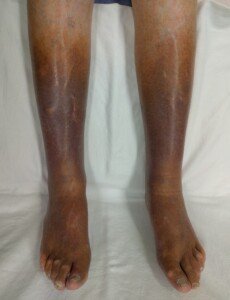
When you see someone with apparent chronic venous insufficiency (swollen red or purple portion on their lower legs), what seems to be the leading causes of this condition?
The question is based on what seems to be a very interesting phenomenon:
Those with chronic venous insufficiency (or at least, swollen red/purple lower legs) are overweight and look very under-exercised.
NOTE: A person can be overweight and also appear to be one who works out.
Well-trained muscles under a thick layer of fat do not go unnoticed.
I’ve seen very toned and firm overweight people, some even with muscle definition, working out at the gym.
They do not have the so-called jiggly, blobby, doughy or mushy appearance.
So I just wanted to make that clear: Being overweight is not another term for looking very under-exercised.

James Heilman, MD, CreativeCommons
Venous insufficiency has multiple risk factors (not direct causes) including obesity, lack of exercise, excessive sitting, smoking and a genetic predisposition.
The visible symptoms can also be caused by congestive heart failure.
But what are the two top causes of the swollen (edema) legs with red and purple discoloration?
“The majority [of chronic venous insufficiency cases] are referred to as primary, related to dysfunction of the valves,” says Seyed-Mojtaba (Moji) Gashti, MD, a board certified vascular surgeon with Broward Health Medical Center in Florida.
Veins Are Valves
Their job is to carry blood back to the heart for re-oxygenation. If the valves (veins) in the legs aren’t working properly, the blood gets backed up and pools in the lower legs. Fluid builds up, causing the swelling.
Malfunctioning valves lead to varicose veins in some people and swollen red and purple/blue legs in others.
Dr. Gashti continues, “The so-called secondary cases are related to an obstructive cause. Most of these cases are in individuals with a previous DVT, as the blood clot prevents the normal flow of blood towards the heart and also to damage of the valves.”
A secondary case of chronic venous insufficiency, like a primary case, can present with swollen reddish or purplish legs.
“A sedentary lifestyle definitely contributes to worsening of venous insufficiency,” says Dr. Gashti.

Shutterstock, txking
As for hardcore data that pinpoints the top two causes of primary venous insufficiency – or the appearance of swollen red and purple legs (regardless of cause) – this data does not exist.
Most vascular specialists believe that winning an unfavorable genetic lottery is the key player in primary vein malfunction.
Dr. Gashti says, “It is an abnormality that has to do with the function of the valves. Not all obese individuals have malfunctioning valves.
“Obesity can exacerbate the signs and symptoms of this condition, but it is not the cause of it.”

Dr. Gashti specializes in the diagnosis and treatment of vascular disease including abdominal and aortic aneurysm.
 Lorra Garrick has been covering medical, fitness and cybersecurity topics for many years, having written thousands of articles for print magazines and websites, including as a ghostwriter. She’s also a former ACE-certified personal trainer.
Lorra Garrick has been covering medical, fitness and cybersecurity topics for many years, having written thousands of articles for print magazines and websites, including as a ghostwriter. She’s also a former ACE-certified personal trainer.
.

























